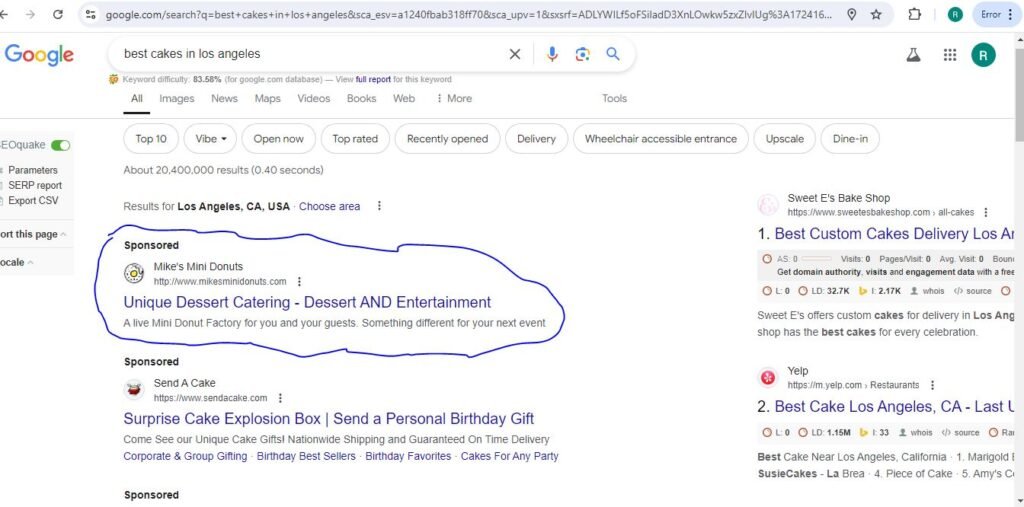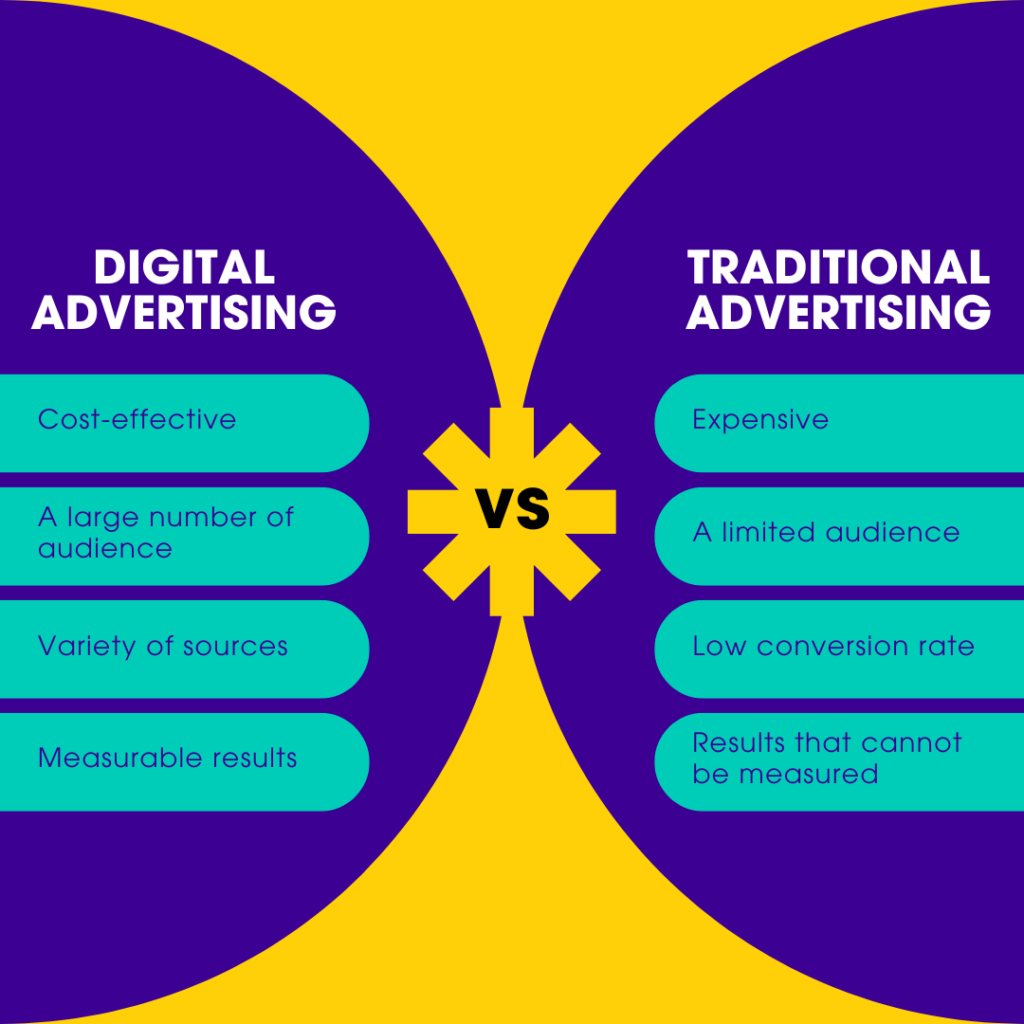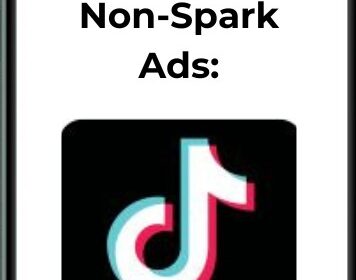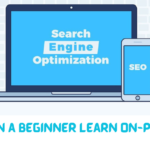These days, there are many different kinds of adverts that we see when browsing the internet. These advertisements are everywhere, from Google to music players like Spotify, which is where we go to listen to music. What really is digital advertising?
According to Statista, as of July 2024, there were 5.45 billion internet users globally, or 67.1 percent of the world’s population. 5.17 billion people, or 63.7 percent of the global population, used social media out of this total. Thus, we can state that there is a 5.45 billion audience that companies may reach with digital advertisements to attract new clients. This promotes brand recognition.
The process of reaching potential consumers with targeted messaging via digital and internet platforms is known as digital advertising. Compared to traditional advertising, this approach has a number of benefits, such as increased audience reach, cost-effectiveness, and precise campaign performance measurement.
In this extensive blog article, you will gain an understanding of the meaning of online advertising, the differences between traditional advertising and digital advertising, the types of digital advertisements as well as the pros and cons of digital advertising. Are you prepared?
What is Digital Advertising?
Assume that you run a bakery. You want more people to be aware of how good your cakes are. Rather than hanging posters across the community, you choose to advertise your bakery online. Essentially, it is the nature of internet advertising.
Digital advertisement is similar to posting signs or informing people about your company online. To connect with people who might be interested in what you have to offer, you can utilize email, social media, websites, and search engines.
For instance, you may purchase the top spot in the search results for “best cakes in Los Angeles” if someone searches on Google. Alternatively, you may make Facebook advertisements to target those who enjoy sweets.

Digital advertising is essentially using internet channels to advertise your goods and services. Websites, social media platforms, and search engines all display digital adverts. Digital advertisements offer the benefit of precision targeting, in contrast to traditional TV, radio, or print advertising. Additionally, they enable you to tailor ad content to the specific receivers you have in mind as well as the context of their online activity.
What is the Difference Between Digital and Traditional Advertising?

#1. Make contact
Conventional Advertising: Targets a large audience in a particular region. For instance, a TV ad airs to all viewers of that station, irrespective of their viewing preferences.
Digital advertising: This may focus on a certain group of people according to their online activity, hobbies, and demographics. For example, users who have looked for running gear may get an advertisement for running shoes.
#2. Cost:
Traditional Advertising: Production, media purchase, and delivery expenses make traditional advertising sometimes pricey. A TV advertising, for instance, may run into the millions.
Digital advertising: Generally less expensive, particularly for small companies. Only outcomes, like as clicks or impressions, are charged for. This facilitates the testing of various advertising initiatives without incurring huge costs.
#3. Measuring
Traditional Advertising: It’s challenging to pinpoint an advertisement’s precise impact. Finding out who viewed the advertisement and if it resulted in a sale is difficult.
Digital advertising: Offers thorough statistics on the effectiveness of ads. Clicks, impressions, conversions, and other metrics may be monitored to determine what is and is not effective.
#4. Targeting
Conventional Advertising: Broadcasts the advertisement to all those who are exposed to it. It is difficult to identify target audiences.
Targeting may be done precisely with digital advertising. People can be shown advertisements according to their location, hobbies, gender, age, and internet activity. This guarantees that the appropriate individuals hear your message.
#5. Engagement
One-way communication is the main focus of traditional advertising. The message is received by viewers passively.
Digital advertising is captivating and interactive. Users are able to exchange material, view videos, and click on adverts. This makes it possible to communicate with potential clients directly.
In conclusion, compared to traditional advertising, digital advertising provides greater control, flexibility, and measurability. It frequently offers greater audience targeting and is more economical.
What Are the Different Types of Digital Advertisements?

After learning the fundamentals of digital advertising, let’s examine the many online audience-reach strategies that companies might employ.
#1. Display Advertising
The visual components that appear on websites, applications, and social media platforms are called display advertisements. They appear in a variety of forms, ranging from straightforward banner advertisements to more engaging rich media commercials. These advertisements hope to draw viewers in and make an impact, which will eventually lead to increased website traffic or the encouragement of desired behavior.
Native advertising is one special kind of display advertising. These advertisements provide consumers with a less invasive experience while conveying pertinent information by blending in seamlessly with the website’s content.
#2. Marketing Using Search Engines (SEM)
People use search engines when they have a particular need or desire. SEM is all about reaching out to these prospective clients at the precise moment they are looking for goods or services similar to yours.
There are two main parts to it:
1. Search Engine Optimization (SEO): enhancing the content and architecture of your website to improve its position in natural search results.
2. Pay-Per-Click (PPC) Advertising: Place your adverts at the top of search engine results pages by bidding on keywords.
With PPC advertising, you can target particular keywords that are pertinent to your industry and ensure that the correct people see your adverts. Read how to optimize PPC Ad Campaigns.
#3. Social Media Advertising
Social media advertising has developed into a sophisticated tool that helps companies connect with, interact with, and win over their target market. Let’s examine a few of the main platforms and the subtleties of their advertising.
1. Facebook Marketing
Facebook provides a great environment for advertising because of its large user base and comprehensive demographic data. Facebook advertising provides a range of ad forms, such as collection advertisements, carousel ads, stories ads, picture ads, and video commercials. Advertisers may target audiences based on relationships, demographics, interests, and behaviors by utilizing Facebook’s vast data.
You may target users who have already visited your website with powerful remarketing campaigns, thanks to Facebook’s pixel.
2. Instagram Marketing
Instagram is a visually-driven platform that provides companies with special chances to highlight their goods or services. Instagram offers a variety of ad formats, including carousel, commerce, story, video, and picture advertisements.
Businesses may work with influencers on Instagram to reach their target audience. This platform serves as a central location for influencer marketing. Because of the platform’s emphasis on images, it’s perfect for developing visually attractive and captivating Instagram advertising campaigns.
3. Twitter Advertising
Twitter is a medium for rapid, effective advertising because of its real-time nature.
Twitter provides sponsored accounts, promoted trends, and promoted tweets as ad formats.
Twitter enables marketers to create timely and relevant campaigns by focusing on consumers based on the topics they are discussing in real-time. Relevant hashtags used well can expand the visibility and audience for advertisements.
4. LinkedIn Promotion
LinkedIn is a professional networking site, which makes it perfect for business-to-business marketing. Sponsored InMail, text advertisements, and sponsored content are available on LinkedIn. Job titles, industry, firm size, and seniority are among the factors that advertisers can use to target professionals.
Also, LinkedIn’s focused advertising campaigns are a good way to generate leads.
5. TikTok Advertising
The short-form video style of TikTok has drawn in a younger audience. TikTok provides brand takeovers, branded hashtags, and in-feed advertisements.
On TikTok, utilizing user-generated material may be quite successful. The platform offers special chances for innovative advertising because of its concentration on music and sound.
Every platform has advantages and disadvantages, and a company’s target market, objectives, and financial constraints will determine which option is ideal for it. In order to optimize reach and impact, a good social media advertising campaign frequently uses a combination of channels.
6. Email Marketing
Email marketing is still a potent digital advertising medium, despite being disregarded quite a bit. You may foster relationships with potential clients, advertise goods and services, and increase conversions by creating a focused email list.
It is possible to efficiently contact your customers and promote repeat business by creating email campaigns that are captivating and include tailored information.
These digital advertising types all have unique benefits and serve various marketing objectives. Businesses may develop a comprehensive digital advertising plan to accomplish their goals by knowing each one’s advantages.
What Are the Pros and Cons of Digital Advertising?
For companies of all sizes, digital advertising has several benefits. It is not without difficulties, though. To assist you in determining whether digital advertising is a good fit for your marketing plan, let’s examine all sides of the issue.
Benefits of Online Marketing
#1. Utilize demographics, hobbies, behavior, and geography to target a broad and niche audience.
Digital advertising provides the most accurate consumer targeting available. Businesses may reach the individuals most likely to be interested in their goods or services directly by utilizing data on demographics, interests, online behavior, and geographic location. This optimizes the possibility of conversions and guarantees the effective use of advertising funds.
#2. Cost-effective: Establish spending limits and pay for targeted activities (conversions, clicks).
Digital advertising offers more control over spending than conventional advertising, which can have significant expenditures and unpredictable results. Companies may opt to pay solely for certain activities, such ad clicks or conversions (purchases, sign-ups), and can specify particular budgets. This pay-per-performance strategy guarantees efficient use of advertising expenditures and aids in optimizing return on investment (ROI).
#3. Measurable: Extensive data tracking and analytics for performance monitoring and strategy optimization.
The capacity to precisely gauge the efficacy of digital advertising is one of its main benefits. With the use of comprehensive analytics, organizations can monitor key performance indicators (KPIs) including impressions, clicks, click-through rates, conversion rates, and return on investment. Businesses may determine what works and what doesn’t using this data-driven strategy, which enables ongoing adjustment and enhancement of advertising efforts.
#4. Interesting: Interactive components, such as surveys, quizzes, and films, improve interest and brand memory.
Static graphics and text are only one aspect of digital advertising. Videos, surveys, and quizzes are examples of interactive components that may fascinate viewers and promote deeper brand interaction. Customers are better able to recall brands and form more lasting impressions as a result of these engaging interactions.
#5. Enhanced Awareness and Visibility of the Brand
An effective platform for raising brand recognition and exposure is provided by digital advertising. Businesses may build a strong brand image and improve their company’s reputation by reaching a large audience through a variety of channels.
#6. Adaptability and Flexibility
Based on performance data, digital advertising strategies may be readily adjusted and changed. Businesses can swiftly adapt to shifts in the market, the activities of competitors, and audience preferences thanks to this flexibility, which helps them optimize their campaigns for optimum effect.
#7. Possibility of A/B Testing
Businesses may do A/B tests on different ad elements, such headlines, pictures, and calls to action, thanks to digital advertising. Marketers may determine the most successful strategies and constantly enhance campaign effectiveness by contrasting many iterations.
#8. Possibility of Developing Client Connections
There are potential to interact more personally with consumers through digital advertising. Email marketing, social media advertising, and interactive content may all help to develop enduring relationships with clients and increase their likelihood of returning.
Cons of Digital Advertising
#1. Ad Blocking: Users can hinder reach and effectiveness with ad blockers.
The growing use of software designed to prevent advertisements presents a difficulty for online marketers. The potential reach of campaigns can be decreased by using these technologies to stop advertising from being shown.
In order to get beyond this barrier, advertisers may consider developing informative content that persuades consumers to turn off ad blockers or looking into other forms of advertising.
#2. Competition: It’s difficult to stand out in a crowded field; you need to provide engaging and original advertising material.
There are many companies fighting for the attention of customers in the fiercely competitive world of digital advertising. Advertisers need to provide unique, captivating, and original ad material to break through the clutter. To effectively communicate with the target audience, one must have a thorough grasp of them.
#3. Privacy Issues: Data collecting procedures may give rise to privacy issues, which calls for openness on the gathering and use of data.
Effective digital advertising requires the capacity to gather and analyze consumer data, but doing so also creates privacy issues. Customers want openness from firms as they become more conscious of how their data is being utilized. To gain the audience’s confidence, advertisers must abide by data privacy laws and be transparent about the ways in which they gather data.
#4. Measurement Complexity: Data interpretation and analysis can be difficult for novices, necessitating the purchase of specialized software or instruments.
Digital advertising provides a wealth of data, but understanding and interpreting it may be challenging, particularly for people without an experience in analysis. Businesses may need to spend money on analytics tools or pay experts in order to interpret the data and get useful insights. Comprehending the data is essential to improving campaigns and attaining targeted results.
#5. Continuous Evolution
With the emergence of new platforms, technology, and consumer behaviors, the digital world is continuously changing. It might take a lot of time and resources to continuously learn and adapt in order to keep up with these developments.
#6. Regulations Regarding Data Privacy
Data collection and usage are subject to restrictions due to stricter data privacy rules. It may be difficult and complex for advertisers to target their audience successfully while adhering to these restrictions.
#7. Ad Fatigue and Other Issues with Digital Advertising
Ad weariness, or the desensitization to advertising messaging caused by excessive exposure to advertisements, can occur among consumers. This can lower click-through rates and lessen the efficacy of ads.
Conclusion
In conclusion, digital advertising has revolutionized the marketing landscape. Its ability to reach a targeted audience, deliver measurable results, and foster engagement makes it a powerful tool for businesses of all sizes. Whether you’re a well-established brand or a budding entrepreneur, digital advertising offers the potential to connect with your ideal customer and achieve your marketing goals.
However, navigating the digital advertising world can be complex. To unlock the full potential of this dynamic platform, consider subscribing to our newsletter on for valuable insights and industry trends.
Additionally, AdsTargets offers a comprehensive suite of digital advertising solutions tailored to your specific needs. Contact our team of experts today and let us help you craft a winning digital advertising strategy. In our next post, look forward to reading the best strategies to find a reliable digital advertising agency near you.










